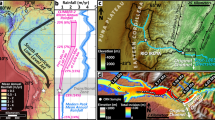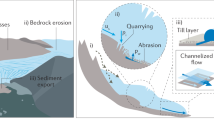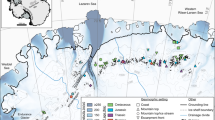Abstract
Climate influences the erosion processes acting at the Earth’s surface. However, the effect of cooling during the Late Cenozoic era, including the onset of Pliocene–Pleistocene Northern Hemisphere glaciation (about two to three million years ago), on global erosion rates remains unclear1,2,3,4. The uncertainty arises mainly from a lack of consensus on the use of the sedimentary record as a proxy for erosion3,4 and the difficulty of isolating the respective contributions of tectonics and climate to erosion5,6,7. Here we compile 18,000 bedrock thermochronometric ages from around the world and use a formal inversion procedure8 to estimate temporal and spatial variations in erosion rates. This allows for the quantification of erosion for the source areas that ultimately produce the sediment record on a timescale of millions of years. We find that mountain erosion rates have increased since about six million years ago and most rapidly since two million years ago. The increase of erosion rates is observed at all latitudes, but is most pronounced in glaciated mountain ranges, indicating that glacial processes played an important part. Because mountains represent a considerable fraction of the global production of sediments9, our results imply an increase in sediment flux at a global scale that coincides closely with enhanced cooling during the Pliocene and Pleistocene epochs10,11.
This is a preview of subscription content, access via your institution
Access options
Subscribe to this journal
Receive 51 print issues and online access
$199.00 per year
only $3.90 per issue
Buy this article
- Purchase on Springer Link
- Instant access to full article PDF
Prices may be subject to local taxes which are calculated during checkout



Similar content being viewed by others
References
Zhang, P., Molnar, P. & Downs, W. R. Increased sedimentation rates and grain sizes 2–4 Myr ago due to the influence of climate change on erosion rates. Nature 410, 891–897 (2001)
Molnar, P. Late Cenozoic increase in accumulation rates of terrestrial sediment: how might climate change have affected erosion rates? Annu. Rev. Earth Planet. Sci. 32, 67–89 (2004)
Schumer, R. & Jerolmack, D. J. Real and apparent changes in sediment deposition rates through time. J. Geophys. Res. 114, F00A06 (2009)
Willenbring, J. K. & von Blanckenburg, F. Long-term stability of global erosion rates and weathering during late-Cenozoic cooling. Nature 465, 211–214 (2010)
von Blanckenburg, F. The control mechanism of erosion and weathering at basin scale from cosmogenic nuclides in river sediments. Earth Planet. Sci. Lett. 237, 462–479 (2005)
Whipple, K. X. The influence of climate on the tectonic evolution of mountain belts. Nature Geosci. 2, 97–104 (2009)
Champagnac, J.-D., Molnar, P., Sue, C. & Herman, F. Tectonics, climate, and mountain topography. J. Geophys. Res. 117, B02403 (2012)
Fox, M., Herman, F., Willett, S. D. & May, A. D. A linear inversion method to infer exhumation rates in space and time from thermochronometric data. Earth Surf. Dynam. Discuss. 1, 207–259 (2013)
Milliman, J. D. & Syvitski, J. P. M. Geomorphic/tectonic control of sediment discharge to the ocean: the importance of small mountainous rivers. J. Geol. 100, 525–544 (1992)
Shackleton, N. J. & Opdyke, N. D. Oxygen isotope and paleomagnetic evidence for early Northern Hemisphere glaciation. Nature 270, 216–219 (1977)
Zachos, J., Pagani, M., Sloan, L., Thomas, E. & Billups, K. Trends, rhythms, and aberrations in global climate 65 Ma to present. Science 292, 686–693 (2001)
Shuster, D. L., Ehlers, T. A., Rusmore, M. E. & Farley, K. A. Rapid glacial erosion at 1.8 Ma revealed by 4He/3He thermochronometry. Science 310, 1668–1670 (2005)
Berger, A. L. et al. Quaternary tectonic response to intensified glacial erosion in an orogenic wedge. Nature Geosci. 1, 793–799 (2008)
Vernon, A. J., van der Beek, P. A., Sinclair, H. D. & Rahn, M. K. Increase in late Neogene denudation of the European Alps confirmed by analysis of a fission track thermochronology database. Earth Planet. Sci. Lett. 270, 316–329 (2008)
Thomson, S. N. et al. Glaciation as a destructive and constructive control on mountain building. Nature 467, 313–317 (2010)
Shuster, D. L., Cuffey, K. M., Sanders, J. W. & Balco, G. Thermochronometry reveals headward propagation of erosion in an alpine landscape. Science 332, 84–88 (2011)
Valla, P. G. et al. Late Neogene exhumation and relief development of the Aar and Aiguilles Rouges massifs (Swiss Alps) from low-temperature thermochronology modeling and 4He/3He thermochronometry. J. Geophys. Res. 117, F01004 (2012)
Steer, P., Huismans, R. S., Valla, P. G., Gac, S. & Herman, F. Bimodal Plio-Quaternary glacial erosion of fjords and low-relief surfaces in Scandinavia. Nature Geosci. 5, 635–639 (2012)
Reiners, P. W. & Brandon, M. T. Using thermochronology to understand orogenic erosion. Annu. Rev. Earth Planet. Sci. 34, 419–466 (2006)
Montgomery, D. R. & Brandon, M. T. Topographic controls on erosion rates in tectonically active mountain ranges. Earth Planet. Sci. Lett. 201, 481–489 (2002)
Thiede, R. C. & Ehlers, T. A. Large spatial and temporal variations in Himalayan denudation. Earth Planet. Sci. Lett. 371–372, 278–293 (2013)
Lague, D., Hovius, N. & Davy, P. Discharge, discharge variability, and the bedrock channel profile. J. Geophys. Res. 110, F04006 (2005)
DiBiase, R. A. & Whipple, K. X. The influence of erosion thresholds and runoff variability on the relationships among topography, climate, and erosion rate. J. Geophys. Res. 116, F04036 (2011)
Pedersen, V. K. & Egholm, D. L. Glaciations in response to climate variations preconditioned by evolving topography. Nature 493, 206–210 (2013)
Sternai, P., Herman, F., Valla, P. G. & Champagnac, J.-D. Spatial and temporal variations of glacial erosion in the Rhone valley (Swiss Alps): insights from numerical modeling. Earth Planet. Sci. Lett. 368, 119–131 (2013)
Willenbring, J. K., Codilean, A. T. & McElroy, B. Earth is (mostly) flat: apportionment of the flux of continental sediment over millennial time scales. Geology 41, 343–346 (2013)
Seki, O. et al. Alkenone and boron-based Pliocene pCO2 records. Earth Planet. Sci. Lett. 292, 201–211 (2010)
Bartoli, G., Hönisch, B. & Zeebe, R. E. Atmospheric CO2 decline during the Pliocene intensification of Northern Hemisphere glaciations. Paleoceanography 26, PA4213 (2011)
Raymo, M. E., Ruddiman, W. F. & Froelich, P. N. Influence of late Cenozoic mountain building on ocean geochemical cycles. Geology 16, 649–653 (1988)
Moore, J., Jacobson, A. D., Holmden, C. & Craw, D. Tracking the relationship between mountain uplift, silicate weathering, and long-term CO2 consumption with Ca isotopes: southern Alps, New Zealand. Chem. Geol. 341, 110–127 (2013)
West, A. J., Galy, A. & Bickle, M. Tectonic and climatic controls on silicate weathering. Earth Planet. Sci. Lett. 235, 211–228 (2005)
Galy, V. et al. Efficient organic carbon burial in the Bengal fan sustained by the Himalayan erosional system. Nature 450, 407–410 (2007)
Mancktelow, N. S. & Grasemann, B. Time-dependent effects of heat advection and topography on cooling histories during erosion. Earth Planet. Sci. Lett. 270, 167–195 (1997)
Dodson, M. H. Closure temperatures in cooling geochronological and petrological systems. Contrib. Mineral. Petrol. 40, 259–274 (1973)
Aster, R., Borchers, B. & Thurber, C. Parameter Estimation and Inverse Problems 2nd edn (Elsevier, 2012)
Tarantola, A. Inverse Problem Theory (SIAM, 2005)
Farley, K. A. Helium diffusion from apatite: general behavior as illustrated by Durango fluorapatite. J. Geophys. Res. 105, 2903–2914 (2000)
Gleadow, A. J. W. & Duddy, I. R. A natural long-term track annealing experiment for apatite. Nucl. Tracks Radiat. Meas. 5, 169–174 (1981)
Green, P. F. et al. Thermal annealing of fission tracks in apatite IV: quantitative modelling techniques and extension to geological timescales. Chem. Geol. 79, 155–182 (1989)
Hurford, A. J. Uplift and cooling pathways derived from fission track analysis and mica dating: a review. Geol. Rundsch. 80, 349–368 (1991)
Hurford, A. J. & Green, P. F. A users’ guide to fission track dating calibration. Earth Planet. Sci. Lett. 59, 343–354 (1982)
Farr, T. G. et al. The Shuttle Radar Topography Mission. Rev. Geophys. 45, RG2004 (2007)
Farley, K. A., Wolf, R. & Silver, L. The effect of long alpha-stopping distances on (U-Th)/He dates. Geochim. Cosmochim. Acta 60, 4223–4229 (1996)
Menke, W. Geophysical Data Analysis: Discrete Inverse Theory MATLAB edn, 3rd edn (Elsevier, 2012)
Ehlers, T. A. & Farley, K. A. Apatite (U-Th)/He thermochronometry: methods and applications to problems in tectonic and surface processes. Earth Planet. Sci. Lett. 206, 1–14 (2003)
Ehlers, T. A. Crustal thermal processes and thermochronometer interpretation. Rev. Mineral. Geochem. 58, 315–350 (2005)
Braun, J., van der Beek, P. A. & Batt, G. Quantitative Thermochronology: Numerical Methods for the Interpretation of Thermochronological Data (Cambridge Univ. Press, 2006)
Wagner, G. A. & Reimer, G. M. Fission track tectonics: the tectonic interpretation of fission track apatite ages. Earth Planet. Sci. Lett. 14, 263–268 (1972)
Gallagher, K., Stephenson, J., Brown, R., Holmes, C. & Fitzgerald, P. Low temperature thermochronology and modeling strategies for multiple samples. 1: Vertical profiles. Earth Planet. Sci. Lett. 237, 193–208 (2005)
Mancktelow, N. & Grasemann, B. Time-dependent effects of heat advection and topography on cooling histories during erosion. Tectonophysics 270, 167–195 (1997)
Braun, J. et al. Quantifying rates of landscape evolution and tectonic processes by thermochronology and numerical modeling of crustal heat transport using PECUBE. Tectonophysics 524–525, 1–28 (2012)
Sambridge, M. Geophysical inversion with a neighbourhood algorithm—I. Searching a parameter space. Geophys. J. Int. 138, 479–494 (1999)
Sambridge, M. Geophysical inversion with a neighbourhood algorithm—II. Appraising the ensemble. Geophys. J. Int. 138, 727–746 (1999)
Herman, F. et al. Exhumation, crustal deformation, and thermal structure of the Nepal Himalaya derived from the inversion of thermochronological and thermobarometric data and modeling of the topography. J. Geophys. Res. 115, B06407 (2010)
Shuster, D. L., Farley, K. A., Sisteron, J. M. & Burnett, D. S. Quantifying the diffusion kinetics and spatial distributions of radiogenic 4He in minerals containing proton-induced 3He. Earth Planet. Sci. Lett. 217, 19–32 (2004)
Guralnik, B. et al. Effective closure temperature in leaky or saturating thermochronometers. Earth Planet. Sci. Lett. 384, 209–218 (2013)
Li, B. & Li, S.-H. Determining the cooling age using luminescence-thermochronology. Tectonophysics 580, 242–248 (2012)
Suppe, J. Geometry and kinematics of fault-bend folding. Am. J. Sci. 283, 684–721 (1983)
Acknowledgements
We thank J.-D. Champagnac and M. Brandon for discussions throughout the study. We also thank S. Jaccard and P. Molnar for their feedback on the manuscript and K. Huntington for her constructive review. The computations presented here were performed on the Brutus facility at ETH Zurich, Switzerland. F.H. was funded by SNF grant PP00P2_138956.
Author information
Authors and Affiliations
Contributions
F.H. designed the study and carried out the data interpretation. F.H., D.S., P.G.V., A.C., B.K. and T.A.E. contributed to compiling the data. All authors contributed to writing the paper.
Corresponding author
Ethics declarations
Competing interests
The authors declare no competing financial interests.
Extended data figures and tables
Extended Data Figure 1 Compilation of thermochronometric ages.
See the source data and associated references in the Supplementary Information for sample locations, elevations, ages and standard error measurements.
Extended Data Figure 3 One-dimensional inversion results for four different erosion histories.
The red curve is the erosion history used to generate synthetic thermochronometric ages. The ages (Myr) for each test are indicated on the figure. The black lines are the most likely solution obtained from the Bayesian inversion. The grey areas represent the 1σ uncertainty around the most likely erosion rate solution. The blue lines are the results of the linear inversion (Methods and ref. 8). The panels on the left depict inversion results using all four systems; the middle panels use AHe and AFT only; and the right panels use AFT only. See text for details.
Extended Data Figure 4 Thermochronometric data from Patagonia15.
See Extended Data Fig. 1 and ref. 15 for further details.
Extended Data Figure 5 Inversion results of Patagonia thermochronometric data set15.
The upper panels are erosion rates predicted by the inverse method8. The lower panels are resolution estimates (with 0.25 contours).
Extended Data Figure 6 Inversion results of ZFT Patagonia data only.
Upper panels are predicted erosion rates with the inverse method8. Lower panels are resolution estimates (with 0.25 contours).
Extended Data Figure 7 Set-up for the three-dimensional thermo-kinematic model.
a, Topography and horizontal extent. b, Vertical extent, initial unperturbed temperature field and imposed kinematic field.
Extended Data Figure 8 Inversion results on three-dimensional synthetic data.
a, Inversion on synthetic data produced with constant 5 mm yr−1 slip rates. b, Same as a using a 1 mm yr−1 slip rate. c, Same as b, but with a slip rate that increases from 1 mm yr−1 to 5 mm yr−1 in the past 2 Myr. Left panels are erosion rates and right panels are resolution estimates.
Supplementary information
Supplementary Information
This file contains the references of the compiled thermochronometric data. (PDF 414 kb)
Supplementary Table
This file contains the erosion rate model Supplementary Table. It includes longitude (°), latitude (°), erosion rates (mm/yr) and resolution. These are the values used for Figures 1, 2 and 3. Note the rates are reported at grid points around existing data location for ease of visualization and reduce weight due the sampling density. Only points from fast eroding areas and with resolution higher than 0.25 for all four time steps are used in Figure 2 and 3b. This file was replaced on 20 December 2013. (PDF 4347 kb)
The time evolution of global erosion rates over the last 8 Myr, resolved into 2 Myr time steps
The time evolution of global erosion rates over the last 8 Myr, resolved into 2 Myr time steps (see main manuscript and Figure 1 for details). (MOV 1653 kb)
Source data
Rights and permissions
About this article
Cite this article
Herman, F., Seward, D., Valla, P. et al. Worldwide acceleration of mountain erosion under a cooling climate. Nature 504, 423–426 (2013). https://doi.org/10.1038/nature12877
Received:
Accepted:
Published:
Issue Date:
DOI: https://doi.org/10.1038/nature12877
This article is cited by
-
A geospatial platform for the tectonic interpretation of low-temperature thermochronology Big Data
Scientific Reports (2023)
-
Mineral weathering is linked to microbial priming in the critical zone
Nature Communications (2023)
-
Long-term erosion rate in the SW Cameroon margin
Environmental Earth Sciences (2023)
-
Cosmogenic nuclide techniques
Nature Reviews Methods Primers (2022)
-
Climatic control on the location of continental volcanic arcs
Scientific Reports (2022)
Comments
By submitting a comment you agree to abide by our Terms and Community Guidelines. If you find something abusive or that does not comply with our terms or guidelines please flag it as inappropriate.



